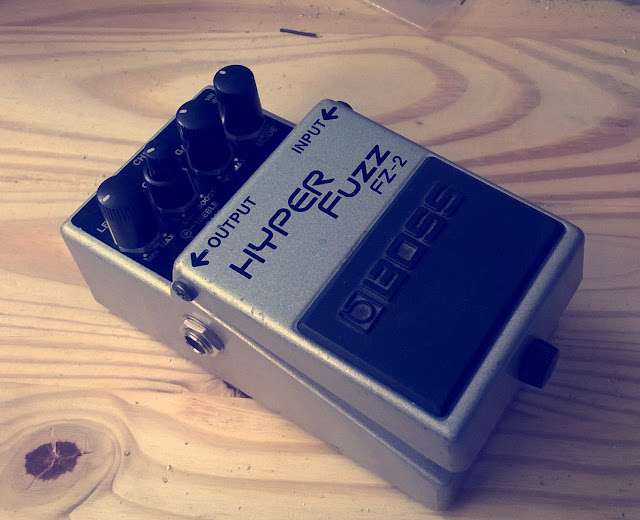1993 is the year when Jurassic Park came out. I think it is no coincidence that another monster appeared this year: the Boss Hyper Fuzz! This pedal, produce from April 1993 to June 1997, is a Univox Super Fuzz clone, with some added features. Mine is from August 1993!
The Univox Super Fuzz is a pedal produce in the late 60s, famous for its apocalyptical sound! It was used by Pete Townshend during live performances of the Who, and then used by many bands with a heavy sound like Kyuss, Fu Manchu or other stoner rock bands. In particular, the Hyper Fuzz is used by Electric Wizard, a band famous for its subtle and thin sound (or not!)... In short, as you understood, this fuzz is a war machine that will crush your ears once activated! It is so evil that legend says: each time you step on it, someone dies...
The FZ-2 is really different from a FZ-3, which is a fuzz with more classic sounds. The Boss FZ3 is close to a silicon fuzz face, whereas the Boss fz2 is really peculiar, really close to a Super Fuzz.
The pedal has 5 controls (the second potentiometer is a double one, and allows you to set bass and trebles). Level sets the volume, second potentiometer sets bass and treble amounts and the gain potentiometer sets the fuzz amount. The last knob lets you choose between three modes: Fuzz I, Fuzz II and Boost that a simple clean boost.

Here is a nice example on a bass:
After opening the pedal, we can see a monolayer PCB, with shapes that look a bit like the Boss DD2:

Here is the most interesting side:

If we take a look at the transistors:

We can see that they are 2SC3378, old transistors that are not produced anymore, which have a really small amplification factor (hfe) of 50. For instance, MPSA18 that are modern transistors have a hfe of nearly 1500!! Indeed, the Super Fuzz has a lot of transistors, and if the gain is too important, the sound will be "mushy" with no sustain. Whereas with low gain transistors, the sound is smooth, heavy and saturated. When the circuit was conceived in the 60s, there were no such things such as high gain silicon transistors, this is why low gain transistors are required to make it work correctly.
Lets take a quick look at the circuit schematic:

First, we can recognize the famous buffer from Boss ("flip flop" circuit in the bottom left corner) that allows the signal to be transformed into low impedance signal. The Super Fuzz circuit is clearly recognizable (from the "gain" inscription to the right side of the image), with the two transistors Q13 and Q14 that are facing each other with a common emitter: they will create the octave sound. Then, there is the bass and treble control circuit with 4 OP amps, and the switch that allows you to choose between Fuzz I, Fuzz II and the boost.
Other added circuits (before and after the Super Fuzz circuit) reduce the signal/noise ratio (evenif it has a lot of gain, this fuzz is not that noisy), and increase the final signal. Indeed, in vintage Super Fuzz, the output signal was really low, and generally lower than the bypassed signal...
It is not a simple circuit, maybe it is even overcomplicated! However, it is true that the vintage Super Fuzz already have a lot of components...
Anyway, I am really happy to have it, it is quite complicated to grab one now, and it is a nearly indispensable tool if you want to play stoner / doom music...
To go further:
Boss Fz-2 manual (pdf)
Boss Area Hyper Fuzz page

1 Comment
Thank you for this detailed analysis!
Answer